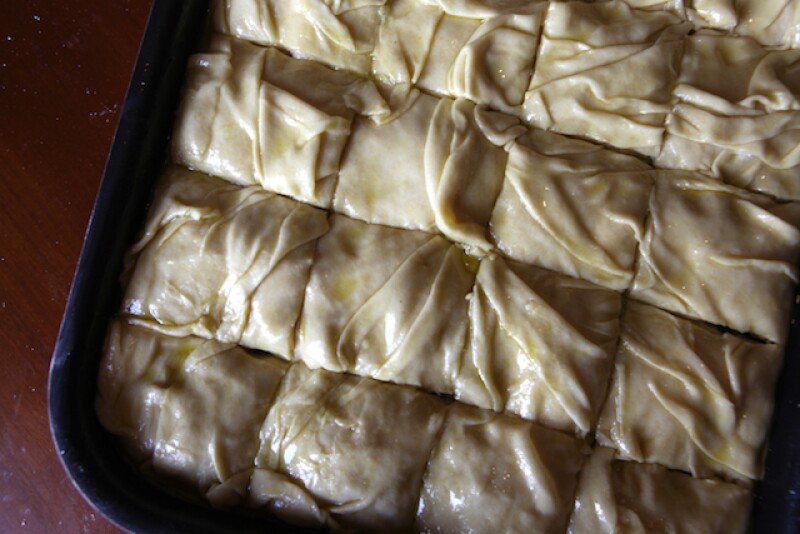When I first heard about the opportunity to make my own phyllo dough with a local in Greece, I imagined hours spent bent over a table trying to coax dough to become impossibly thin. There was a real air of mystery about the delicate, flaky pastry dough, and I didn’t believe I could make with my own hands—but then I met Christina. She who grew up eating her grandmother’s handmade phyllo pies and went on to learn the art of phyllo-making in a local Athens pie shop. She invited me into her modest home in central Athens to teach me how to hand-roll dough into paper-thin sheets.
Christina told me that the story of phyllo is really a story of the world’s first sustainable packaging. It was used as a way to wrap vegetable-and-cheese- laden lunches for farmers and herders, whose jobs required them to be away from their homes all day. The hand pie has come a long way, and now you can see versions throughout the streets of Athens and beyond. But its utility still remains: It’s a quick bite to eat on your way to or from or at work.
Speaking of work, making phyllo dough takes a lot of it. The first step in making our phyllo pie wasn’t the dough at all, but the filling. We were making spanakotiropita, a cheesier version of the well-known spanakopita, or spinach pie. We started at Christina’s kitchen sink, the largest vessel available to mix the pounds and pounds of spinach and wild greens that went in to our pie filling.

Photo by Steph Lawrence
The filling looked like a mouthwatering meal in itself: spinach, leeks, onion, and parsley mixed with fresh eggs, which Christina had brought from her coastal home village a few hours from Athens, and a variety of Greek cheeses—feta and mizithra and anthotiros—and seasoned with salt and dried oregano.
When the filling was finished, we moved to her dining room table to begin rolling the dough. Christina made the entire process look seamless, measuring everything by feel, while I relentlessly prodded her for specifics about ingredients and measurements to recreate the recipe at home.

Photo by Steph Lawrence
Phyllo begins, like all doughs, with flour, which is mixed with water, salt, olive oil, and wine. The real art of phyllo comes in the “opening” process—the transformation from a ball of dough into a paper-thin sheet. I was amazed at how easy Christina made the process seem: a simple flattening of the dough with a regular rolling pin, followed by several rolls with a thinner rolling pin (basically a half-inch dowel) to “open” the dough.

Photo by Steph Lawrence
There was some technique to the process, to be sure, but I followed Christina’s lead and opened several sheets myself with no problem. We then layered the phyllo sheets—each brushed generously with olive oil—and then added the spinach-and-cheese filling. Then we topped the pie with a final phyllo sheet.
The best part of making phyllo? There are so many layers and folds that it doesn’t matter if there are holes in your phyllo from rolling it too much, or if something tears during the long process. It all bakes together in a tremendously crispy, flaky pie.

Photo by Steph Lawrence
Although my Greek rolling pin for making phyllo was confiscated at the airport (too dangerous, the security guard said), I’ll be finding a replacement soon to recreate the authentic spinach and phyllo pie in my own kitchen.
Want to book your own phyllo-making experience with Christina? You can! Book now with Traveling Spoon. If you won’t be heading to Athens any time soon, here’s how to make phyllo at home.
Traveling Spoon connects travelers with authentic food experiences, from meals to market tours to cooking classes, in local homes around the world. Learn about food traditions passed down through generations and travel off the eaten path.











